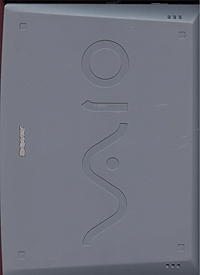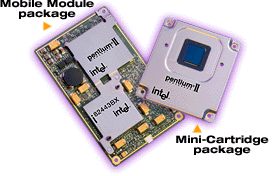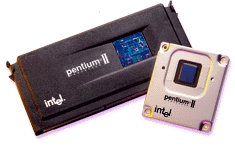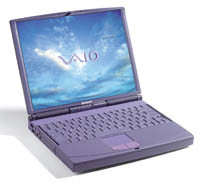
Original Link: https://www.anandtech.com/show/229
Sony VAIO PCG-818 Pentium II 300 Notebook
by Anand Lal Shimpi on January 19, 1999 2:52 PM EST- Posted in
- Systems
| With the internet at the fingertips of just about every novice computer user, it is amazing to think back to how things were just 10 years ago, without the conveniences of 56K, Cable, and DSL connections, and especially without the hardware conveniences that have since been integrated into circuits that can fit into the palm of your hand. |
|
|||||||||
| One of the most technologically advanced
facets of computer hardware, more specifically, PC hardware, is, without a doubt, the
improvements the market has seen in mobile products. Microprocessors are getting smaller,
running faster and cooler, and consuming much less power than they did just a year ago.
Computers have become an integral part of today's society, taking the analog nature of man
and combining it with the digital nature of the era that surrounds us all. Thinking back to 10 years ago once again, you would probably never have thought of purchasing a Sony made computer, much less a laptop, however since that time, Sony has made themselves into a heavy weight contender in the desktop and laptop PC industries, especially with their VAIO series of products. The name VAIO, according to Sony, is representative of that very idea discussed above, the integration of the analog and digital worlds, since the VAIO logo is essentially composed of a trigonometric sine wave transforming into a binary number, 101010. Although many readers of AnandTech will find themselves cringing at the thought of purchasing a retail system, as a laptop, Sony's latest concoction, the VAIO PCG-818 based on Intel's new mobile Pentium II processor, definitely has the capability of satisfying even the most power hungry users. For those of you looking to give your Celeron 450's a rest while you're on the road, yet don't want to lose out on your net life while away, Sony has quite a bit to offer with this high-end VAIO product. |
||||||||||
Click here to find lowest prices on this product.
| Sony VAIO PCG-818 Product Specifications | |
Processor
Cache Memory
Bus Architecture
LCD
Graphics
Digital Audio
MPEG
Standard RAM
Hard Drive
Drive Bay
DVD-ROM Drive
Floppy Disk Drive
Modem
Pointing Device
Speakers
Microphone
Battery
Maximum Battery Life
PC card slots
InfraRed
Port Connectors
|
Power
Requirements
Power Management
Size (W X H X D)
Weight
Supplied Accessories
Service
Limited Warranty
Telephone Support (24 Hours, 7 Days a Week)
PRE-INSTALLED SOFTWARE
Sony VAIO Space II
Software Applications
Online Center
Tool Center
|
Click here to find lowest prices on this product.
The Shell
| Sony's VAIO (Video Audio Integrated Operation) product line has always set itself apart from the competition by its unique purple-ish color, and futuristic demeanor. Fortunately, unlike some competing product lines, the VAIO line backs up its attractive looks with comfort an absolute plus. The PCG-818, in spite of its "high-end" label, does come in an extremely lightweight and manageable package. Unlike many high-end laptops, which follow up their impressive, desktop-like, specs with a bulky design, the PCG-818 does the exact opposite. Growing out of the roots of the elder VAIO laptops, the PCG-818 is a barely larger than a sheet of paper with it's 11.7" width and its 9.3" depth. The laptop is also a mere 1.75" thin and weighs in at an acceptable 5.9 lbs. |  |
| Unfolding the 13.3" XGA Active Matrix LCD display from its seated position, AnandTech was able to take a good look at the shell of the expensively tiny laptop. The large keyboard didn't seem to be a proper match for the size of the laptop itself, however for those of you that are consistently complaining about the size and comfort of typing on a laptop keyboard, the PCG-818's keyboard comes as close to a full sized PC keyboard without using any butterfly storage techniques. | |
| The keys themselves do seem to be a bit low-profile, making proper fingering of the keys a bit of a problem, especially if you're searching for a key in the dark (just in case you happen to like working at night in your hotel room). During the evaluation of the laptop, AnandTech had very little trouble adjusting to the keyboard on the PCG-818, and was definitely pleased by the overall quality of the design. |  |
As with all other Sony notebooks, as well as most competing products, the pointing device on the PCG-818 is a digital touch pad positioned just south of the keyboard. The two button device can be a bit difficult to operate, and definitely makes dragging/dropping, highlighting large tables, and general navigation of applications a bit tricky in comparison to your good ol' mouse. Many users will opt to use their favorite Windows shortcuts wherever possible, as the touch pad can grow to be quite the annoying feature. Luckily, Sony's configuration software does allow for a very useful option to remove some of the problems touch pads have posed in the past, such as disabling the touch pad while typing, therefore preventing any accidental movement/operation of the device.
Moving around to left side of the laptop, Sony has outfitted the PCG-818 with two bays, both custom-fit for their contents, the first being the primary battery storage bay, and the second being the removable hard drive bay. The system ships standard with a single battery pack, and a 6.4GB 2.5" Toshiba EIDE hard disk in the removable HDD bay. Also on the left you have the audio I/O ports for the bundled headphones, a microphone (not included), or external speakers (not included).
The rear of the laptop, as you can probably expect, is home to the built-in port replicator which consists of: 1 PS/2 port (for KB/Mouse), 1 9-pin Serial port, 1 VGA connector, a parallel port, and a USB port. Also located on the back panel is an interface connector for an optional docking station, as well as an infrared port for wireless data transfers and communication. The bundled AC Adapter/Battery Charger plugs into the back of the laptop as to prevent any entanglement of wires while not running off of the system's battery.

While many other manufacturers will strip their laptops dry before weighing to provide their customers with an absurdly low figure, Sony does the exact opposite once again. The 5.9 lbs weight is with both, a battery pack and the DVD-ROM drive installed in their appropriate bays. Removing the included DVD-ROM drive and replacing it with an also included 3.5" floppy drive took the weight down to 5.7 lbs, and by removing the occupants out of the floppy/DVD-ROM drive bay and installing Sony's provided "weight-saver" bay filler, the total weight of the laptop (and batter) dropped down to an incredible 5.3 lbs.
Click here to find lowest prices on this product.
Turning it inside out
| At the heart of the PCG-818 is Intel's latest mobile processor, the mobile Pentium II running at 300MHz. The beauty of the mobile Pentium II processor is its low profile design, allowing it to plug in directly to the motherboard and occupy a very small amount of vertical real estate, which is key to making a thin laptop. Since the processor is barely elevated over the surface of the motherboard, placing a low-profile heatsink/fan on top of the processor to channel the heat away from the source becomes quite a simple task. |  |
| In order to make cooling less of a Herculean task, the mobile Pentium II is designed to run at a lower core voltage in comparison to the desktop Pentium II processors we're used to using. Instead of operating at 2.0v, like most newer desktop Pentium II processors, the mobile Pentium II, like the Pentium III, operates at a 1.8v core voltage effectively decreasing the power consumption of the CPU as well as the heat dissipated by the 300MHz demon. | |
Performance wise, there is no real difference between a desktop and a laptop Pentium II 300, the real performance differences become apparent between desktops and laptops when you factor in the video and mainboard chipsets, two areas manufacturers often skimp on to cut costs when making a "high-end" laptop. The perfect example would be the PCG-818, although it makes use of the same 440BX chipset found in desktop computers, the PCG-818 lacks one major feature of the desktop BX chipset, which is AGP support. The lack of AGP support on the PCG-818 immediately makes the laptop a poor buy for anyone that might be using the laptop for games, or anyone that is interested in the long term value of the notebook. Most newer laptops are coming shipped with ATI Rage Pro AGP 2X compliant video chipsets on-board, however Sony chose to forego that route in favor of a cheaper 2.5MB PCI NeoMagic MagicMedia graphics accelerator.
| Although the MagicMedia accelerator supports both Direct3D and MPEG acceleration it fails to provide the performance a 300MHz Pentium II should be paired up with. Naturally there are power consumption and heat considerations that Sony had to take into account, making an on-board Voodoo2 or TNT accelerator out of the question, however an AGP ATI accelerator would've been preferred over Sony's chosen solution with NeoMagic. |  |
As briefly mentioned before, the PCG-818 comes equipped with a removable 2X DVD-ROM (it also doubles as a 20X CD-ROM) drive and a software DVD decoder capable of playing full speed, full screen DVD-movies with extremely high quality playback comparable to that of a home unit. Smooth playback is possible, although only while running the notebook at full speed, if Sony's power management utility kicks in expect to see extremely choppy playback of your video until you restore the laptop to its full speed. Of course there is only so much entertainment you can get from the tiny speakers tucked carefully away underneath the monitor on the PCG-818, and in an airplane you're going to want something a little closer to home for sound, in which case it's time to break out the trusty headphones Sony provided with the laptop. The headphones are your standard Sony ear-piece headphones, so you'll probably not want to share them with your neighbor for sanitary reasons, and they concentrate the sound close enough to your ears that you get a much better overall experience out of the DVD player when using the headphones rather than the built-in speakers. A unique feature of Sony's bundled headphones is the wired remote that they plug into, which then plugs into the laptop allowing you to adjust the volume, skip from track to track when playing a CD, stop playback, and pause all from the palm of your hand. It's a neat little gadget, although after connecting the headphones to the wired remote and then it to the laptop AnandTech had a nice little tangled mess to play around with.
While the removable DVD drive is not in use, the sole removable drive bay can be occupied by either the supplied Floppy Drive or by an optional second battery pack. Since the floppy drive is very rarely used, in order to save weight on your should or on your lap you may want to install the bundled weight saver which is nothing more than a plastic cover for the bay until you can find another movie to pop in the DVD drive. Should the need arise that you have both the DVD and the floppy drives available for use at the same time, Sony allows you to make use of the parallel port interface on the back to connect the floppy to and leaves the DVD drive safe and sound in the removable bay. Unfortunately the DVD drive is not hot swappable, in that you must reboot the computer after installing the DVD drive in the removable bay, which can be quite a bit annoying at times.
At the same time, while you're playing around with the removable drive bay on the right side of the PCG-818, there are two pretty much standard features on the 818 that are noteworthy. The removable 2.5" EIDE Toshiba 6.4GB HDD positioned towards the back of the laptop on the left hand side is a standard sized notebook hard drive, and easily slides out of its removable bay for quick replacement. The bay can accept all 2.5" notebook drives, however whether or not the on-board BIOS can detect drives larger than 9GB is still up for question, it should, but you never know. Before upgrading the hard drive in the 818 you'll want to confirm that the BIOS does support drives larger than 9GB with Sony just to be on the safe side.
Towards the front of the laptop you'll find the removable battery bay occupied by the supplied rechargeable Lithium Ion battery. Although Sony claims a maximum battery life of 4 hours for the single battery, in reality you can expect the battery to last a little over two hours, just enough to watch a full length DVD movie. Sony also allows for an optional second battery to be installed in the removable drive bay, effectively doubling the battery life of the laptop. A second battery is definitely recommended for any long trips without access to a wall outlet for recharging, although the battery itself will run you an extra $240. At the time of the review, Sony was offering a $150 rebate on an additional battery pack however that offer may not be valid during the time of publication.
Click here to find lowest prices on this product.
The Belly of the Beast
Looking at its underside, the PCG-818 has very little to hide. Unlike the cheaper design of most no-name Pentium laptops, there are no air-vents on the underside of the PCG-818. Then how does the processor get cooled? Through the sides of course. The intake/exhaust from the CPU fan is directly above the microphone input jack on the left side of the laptop, allowing you to rest the notebook on your lap, or even a carpet without having to worry about getting enough air in to cool the system. Be warned, after 45 minutes of continuous usage the bottom of the PCG-818 became quite hot and although the system did not grow unstable, to be on the safe side you'll probably want to place it on a less heat-retaining surface than carpet for prolonged usage.
There are two access points to the motherboard inside the case of the PCG-818 on its belly, one being access to the 2.5MB of installed video memory and the other being an empty SO-DIMM (Small Outline Dual Inline Memory Module - essentially a smaller version of the DIMMs used in desktops) SDRAM bank for system memory upgrades. The system AnandTech tested came equipped with 64MB of SDRAM, and is upgradable to 192MB with an additional 128MB SO-DIMM. At the time of the review Sony was not offering any upgrades for the PCG-818, and an inquiry to Sony's sales line received a response that AnandTech should try contacting third party memory vendors about upgrades. This provides two disappointments, the first one being that there is only a single DIMM slot for expansion (so if you upgrade, you better make it count), the second being that Sony's sales staff was essentially clueless about the type of memory used by the PCG-818 and wouldn't even give AnandTech a model number. At the time of the review most online vendors only carried memory upgrades for the Pentium MMX modules of the VAIO laptops, and not the PCG-818, however in time Sony should begin to offer the upgrades as well as online vendors.
Firing it Up
Turning on the PCG-818 revealed a fairly quiet operation and a relatively short boot-time of under 30 seconds. The clicking of the keys on the keyboard can be quite annoying, even when touch-typing, however the overall operation of the PCG-818 could be considered to be generally quiet and nonchalant. The greatest noisemaker seemed to be the DVD-ROM drive while spinning up, however after it started going everything returned to just about normal.
If all you're going to be doing on the system is word processing, you can use Sony's included PowerPanel power management utility to power down the CPU to a slower speed, and to decrease power to components such as the LCD backlight. Also, as you decrease the CPU speed, the CPU fan will shut itself off and turn itself back on when needed, decreasing the amount of noise generated by the already quietly humming PCG-818. The PowerPanel utility is accessible from a hidden bar on the right hand side of the Windows 98 desktop or through the system tray, and is fully configurable to suit your personal needs.
Around 500MB of the 6.4GB Toshiba HDD was occupied out of the box, leaving a little under 6GB free for AnandTech to play around in. One of the great advantages to having a Pentium II 300 under the hood is excellent performance under Windows NT, making the PCG-818 the ideal Windows NT workstation while you're on the road. You have to keep in mind that the Pentium II 300, even though it is a mobile solution, still have 512KB of L2 cache running at 150MHz, giving it a huge performance advantage over its K6-2 competitors in the mobile NT field. Unfortunately the laptop did not ship with NT drivers for either the sound or video devices, leaving you with a bit of searching to do on-line before your mobile NT powerhouse can be fully functional. Luckily NeoMagic can be reached via their website at www.neomagic.com, so the journey for drivers isn't as futile as you might expect.
The on-board V.90 56K modem comes in quite handy when you're stashed away in a hotel room far away from any high speed internet connections. The jack is placed on the right hand side of the laptop next to the two 32-bit PC Card/Cardbus compatible slots, and since the modem is built into the laptop that frees up one of the otherwise occupied PC Card slots for use with an Ethernet card, Flash memory upgrade, or anything else you can think of using it for.
The beautiful 13.3" XGA screen runs natively at 1024 x 768 x 16-bit color, which was what the PCG-818 shipped at and it produced vibrant colors while staring directly at the screen at that resolution. Unfortunately there was a bit of white fading around the corners of the screen, and the screen, like most LCD screens, became virtually invisible when viewed at an angle. Although you could consider that a privacy feature to prevent people from looking over your shoulder, it is definitely an annoyance to those that can't assume a straight forward position for prolonged periods of time while working on a laptop. A problem with active matrix LCD screens is the lack of a standard, perfected manufacturing process, so there will be cases in which your LCD may have one or more pixels turned on by default. This is simply a manufacturing error and can be expected with active matrix displays. Usually you'll find no more than 2 or 3 pixels which appear to be turned on at all times, for example, the PCG-818 AnandTech tested featured a single red pixel in the lower right hand corner of the screen that remained on at all times. Luckily the Windows 98 taskbar covered it up quite nicely, unfortunately chances are that not all PCG-818 owners will be that lucky.
Features such as brightness and contrast controls can be adjusted via a keystroke combination using the function key placed to the right of the left Control key on the keyboard. The poor placement of the function key does interfere with touch typing Windows keystroke combinations, i.e. ALT + F4 or CTRL + F4, and can get quite annoying at times if you consistently hit FN + F3 instead of CTRL + F3. The function key also allows you to mute the audio as well as control volume, two keystroke combinations that should be the first things you learn if you ever take the laptop into a public place. As much as the people sitting next to you love the Microsoft startup sound, chances are that they don't want to hear it blasting out of your speakers.
Click here to find lowest prices on this product.
Performance & Stability
The performance of the PCG-818 is comparable to a poorly made desktop 300, in that the performance of the hard drive and the video card slows the overall system performance down a few notches. That can be expected since it isn't really practical, once again, to outfit a laptop with a 7200-RPM SCSI hard drive and a nVidia Riva TNT graphics accelerator, although a better chosen graphics chipset would've been favorable in this case.
The processor and memory sub-system performance in this case is top notch for a laptop, something which was seemingly impossible just a few years back. The 512KB of L2 cache running at 1/2 clock speed (150MHz) truly helps with the business performance of the PCG-818, making windows fly open and document editing productivity no longer limited by the speed of your processor rather how fast you can operate the sluggish track pad.
The disk performance of the PCG-818's Toshiba drive is about half the performance you can expect from a normal desktop EIDE disk, which isn't too bad considering that you'll very rarely use a laptop for extremely disk intensive applications. Sony does offer an additional 4GB add-on drive through their VAIO Direct Website, however if you've ever looked into buying a new hard drive for a notebook, the price can be a highly discouraging factor.
The stability of the system is average for a desktop, however since a laptop isn't generally viewed as a server/workstation environment computer the few crashes AnandTech experienced during the testing process could be considered "normal" for a laptop.
The Final Decision
| For $3000, the PCG-818 is a bit overpriced for the common user, and with Intel boasting the ability to offer a 600MHz+ mobile processor before the year's end an investment in such an expensive unit would not be the most intelligent one to make. However if you need the performance now, and you don't mind spending $3000 on a laptop which will be worth less than half that in 6 months time (welcome to the world of computer hardware) then the combination of a long lasting battery life, a sleek and easy to manage design, and a high performance multimedia solution make the Sony PCG-818 a clear winner. |
|
|||||||||||||||||||||
| If you are in the market for a laptop of this caliber, you may also want to consider some of the latest offerings from Micron and IBM as well, as both of them happen to have high performance, low profile offerings featuring the mobile Pentium II processor. As a laptop that you can go out to your local Best Buy or CompUSA and pick up, the Sony has the retail competition beat, but before you slap those crisp new hundred dollar bills on the counter you may want to do a little surfing to see if you can get a better deal on a more attractive laptop. | ||||||||||||||||||||||








